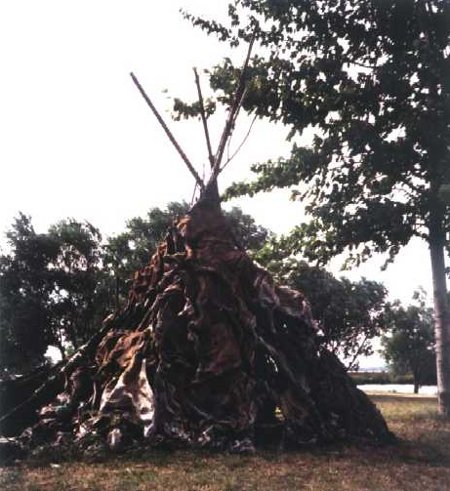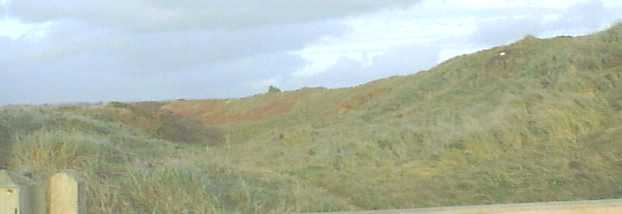Hengistbury Head Pre-History
Upper Paleolithic period (pre 6500BC)
The occupation of Hengistbury Head dates back to 10,000 BC. Some significant finds from this period have been made at Hengistbury Head. This first period of occupation falls into a period known as the Old Stone Age or Upper Paleolithic period. During most of this time the English channel had yet to be completely flooded and Hengistbury Head lay on the edge of a large river valley ( the river Solent ) with the sea many kilometres distant beyond the chalk ridge stretching from the Needles to the Old Harry Rocks (Of course neither of these two structures existed then, they were part of the Chalk ridge). Until the discovery and containment of fire, the succession of ice ages made this area generally too cold for human habitation and visitors were nomadic and occasional. Around the Dorset locality, many finds from the Upper Paleolithic period have been made, but only a few match the quality of those found at Hengistbury Head.

Paleolithic hunting tent (courtesy Wikipedia)
These finds probably relate to one or a small number of nomadic hunters that camped on the high ground offered by the Head. Here they were near the Grand Solent river and some of its main tributaries (including the Avon and Stour) and must have been close to watering and migration routes for Deer, Bison, Horses and possibly Mammoths . These people probably followed the migration paths of their prey and had several semi fixed camps that they used through the seasons. These people had only stone tools and weapons but they were very skilful in their manufacture. Some prize examples have been found at Hengistbury Head, mainly on the top of Warren hill. These flint, bone and antler tools formed the every day tools these people needed such as scrapers, spear heads and knives. Hengistbury head is one of only 25 sites from this period found in this country. The majority of the finds have been in or near caves. Only 4 non cave sites have so far been identified,including the one at Hengistbury Head.
Mesolithic period( 6500 - 4000 BC)
As the last Ice age of the Paleolithic period came to an end the climate became warm and moist. This change in climate led a major change in to the type of vegetation that dominated this area and large tracks of previously open tundra turned into dense forest. Most people of that period lived along the coast or along river channels as the development of these thick forests over England made inland penetration both difficult and unnecessary. It should be remembered that Hengistbury was at this time still a fair way inland from the sea and consequently was probably only rarely visited by passing hunters. Occasional finds from this period have been made but they are few and far between.
Even though it was heavily defended by the Double Dykes ramp and ditch defence, Hengistbury Head gave up without a fight during the Roman invasion of 43AD.But little changed with the arrival of the Romans. Hengistbury Head continued to flourish as a trading port for the next 400 years.
As time went on, Hengistbury Head was replaced by larger and more accessible ports, like nearby Poole. Hengistbury Head returned to being desolate uninhabited wasteland. Occasional useage was made of the site, usually as a look-out post during a national emergencies but other than that Hengistbury Head was allowed to slumber through several centuries.
Neolithic period ( 4000 - 2000 BC)
The heavy forestation period of the Mesolithic period lead people to congregate along the coastlines and move away from the typical nomadic hunter gatherer lifestyle. This proceeded through to the Neolithic period which had communities now following a more static lifestyle, as herdsmen and farmers. Gradually they moved inland forming settlements as they went. Great numbers of early Neolithic stone implements have been found on the head although there is currently no evidence for occupation. Towards the end of this period other imported good began to appear in the Christchurch area. Several tools made from non local stones have been found that indicates that trade had developed between the people living in the Christchurch area and with communities in Devon and France.
Bronze age (2000 BC - 600 BC)
Several Tumuli (burial mounds) that date from the early part of this period have been discovered on Hengistbury Head. These tumuli have been found to contain the cremated remains of individuals, thought to be important local individuals. Other items found in the tumuli include various pottery and animal remains. It is believed that part of Hengistbury head was essentially an early bronze age cemetery, at least for the local rich. A great deal of archeologically valuable material has been retrieved from the funeral barrows and the materials discovered are typical of what is known as Wessex culture or early Bronze age. An interesting feature of the barrows on the head that was disclosed by the two main archaeological investigations of Bushe-Fox (1913) and Gray (1922) is that the barrows all contained a scattering of earlier flint tools and weapons. This would indicate that the barrows were built upon land that had been previously occupied, so the cemetery only appeared after the head and vicinity had been settled. Towards the end of this period it appears (from the lack of finds) that the head was either sparsely populated or abandoned completely for a period of several hundred years.

The Double Dykes. An impressive Ramp and Ditch defence at the base of Hengistbury Head
Hengistbury Head became a metalworking centre utilising the local iron ore resource in the Ironstone Doggers.Other metals were also worked including Silver and Bronze. The Hengistbury Head settlement rapidly developed and became a primary trading port, importing wine tools and pottery from as far away as Italy. Many coins from this era have been found, interestingly some of which appear to be forgeries with a bronze base given a dip coating of silver!